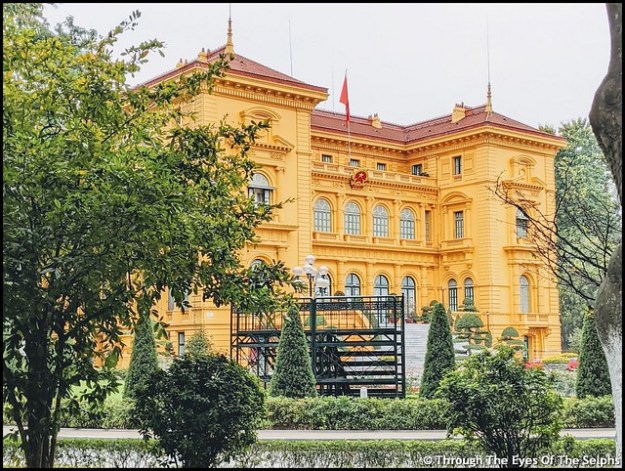Our last stop in Vietnam was the port of Halong Bay.
Our first day was most certainly a long one. We had a ten and a half hour excursion to Hanoi. Yes, ten and a half hours. The reason it was so long was because it takes two and a half hours to get to Hanoi from Halong Bay by bus. So round trip it is five hours on the bus! But first we had to get a Vietnam Landing Card which we had to present to Vietnamese immigration officials upon leaving the ship. 
Along the way to Hanoi we saw field after field of rice paddies. 
We also saw a main bridge into the city that had been heavily damaged during the war and rebuilt. It is still in use today. 






Hanoi, with 6.5 million people, is the second largest city in Vietnam and the capital city. Located on the Red River, it was heavily bombed during the Vietnam War. During its turbulent history Vietnam has been attacked or ruled by the Chinese, Japanese and French. The strong French influence throughout Vietnam is seen in its architecture and food such as baguettes.
We had a young male guide named Ang. Every guide we have had in Thailand and Vietnam has been male. Ang spoke and understood English very well. This is the Flag Tower of Hanoi built in 1812. 
As we drove and walked through the streets it was interesting to see how the people lived and socialized. Hanoi seemed older and less modern than Saigon. Traffic was not quite as bad but we did see a T shirt in a souvenir shop that said “I Survived Hanoi Traffic”. 
Another popular shirt in Vietnam for tourists is a traffic light laws with GREEN/YELLOW/RED and the three phrases: I can go, I can go, I still can go.
We saw “Grab” which is similar to our the ride-sharing Uber, except Grab uses a motor scooter, not a car. 

Our guide took us on a walking tour of Ba Dinh Square in Old Hanoi with thirty-six narrow streets where pedestrians and motor scooters fight for space. We had noticed while in Saigon many tiny little tables and chairs sitting around outside stores and restaurants and surmised they were for small children. We were surprised to see adults sitting on these tiny seats eating their lunch. 
Also taking up sidewalk space were motor scooters. With no place to park, they simply park on the sidewalks, leaving pedestrians to walk along the busy streets. Later at dinner a fellow passenger, who had taken this walk with another group, reported seeing a large dead rat in the street. 


We continued to be amazed at the huge mess of power lines throughout the city. We couldn’t imagine attempting to repair these lines. The solution seems to be to leave the old bad wire in place and just put up new wire. 
We saw familiar stores like Circle K, KFC, Burger King, New York Pizza, and of course McDonald’s. 
This advertisement was outside a store. To put it in perspective:
Ang was very proud of our next stop, the Temple of Literature. This is where Vietnam’s first university was built in 1070 and dedicated to Confucius. Since it was a holiday for the Chinese New Year, it was mobbed with people. Contrary to the name, we didn’t see any books! 




After a five course lunch of traditional Vietnamese dishes at a local hotel, we went to the Ho Chi Minh Tomb and Presidential Palace area. 

Ang spoke very reverently about Ho Chi Minh and what he did for the Vietnamese people. The tomb was huge with guards standing at attention. A line was drawn on the sidewalk and if anyone stepped across that line one of the guards would blow a whistle. Ang said Ho Chi Minh wanted to be cremated and his ashes spread throughout the countryside. But other leaders wanted him to have a big tomb like leaders in Russia. 
We saw cars given by Russia to Ho Chi Minh and apparently Ho Chi Minh and others wanted to model their lives after Stalin and other Russian leaders. 
We saw the Presidential Palace which Ho Chi Minh used as an office and when greeting foreign dignitaries. According to Ang, Ho Chi Minh refused to live in the palace, instead choosing to live in a smaller house nearby for three years. 

Later in his life he lived in an even smaller more traditional Vietnamese house on stilts. Nearby was a bunker he could be taken to during an attack. 
This small concrete green block house is where he was living when he died. 
Unlike our guide in Saigon who was critical of life in Vietnam, Ang had nothing negative to say.
It was a tiring day and a long ride back to the ship. But we were glad we saw this historic city we had read so much about during the Vietnam War years.
Here are some views we saw on our way back to Halong Bay. There were many people selling these fresh fruits by the bag.



Halong Bay at night.

After dinner we were passing through the Lido area to walk around outside and were greeted by a huge Chinese dragon who was visiting for the Chinese New Year. 



The house on stilts are
Like the houses in rural areas of Malaysia. They also ride on scooters and the entire family rides. All the colors reminded me of Chinese New Years when we were in SE Asia.